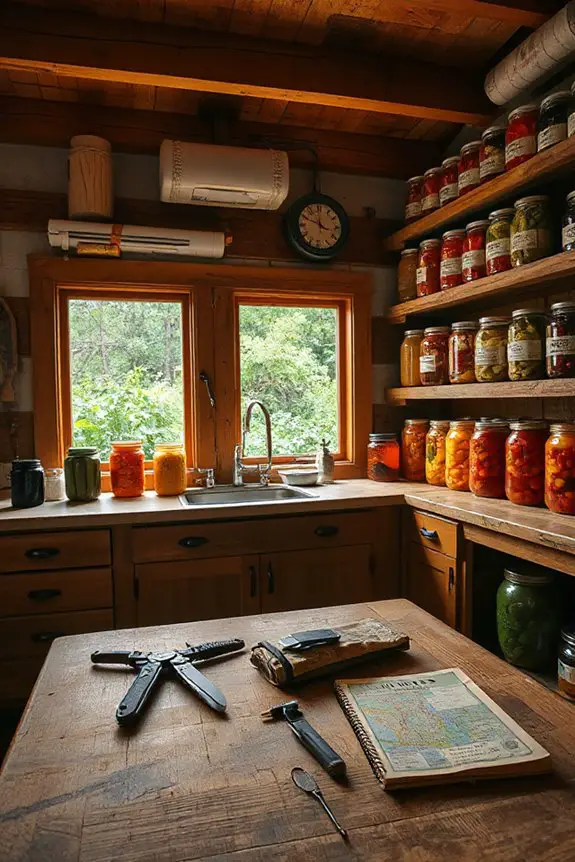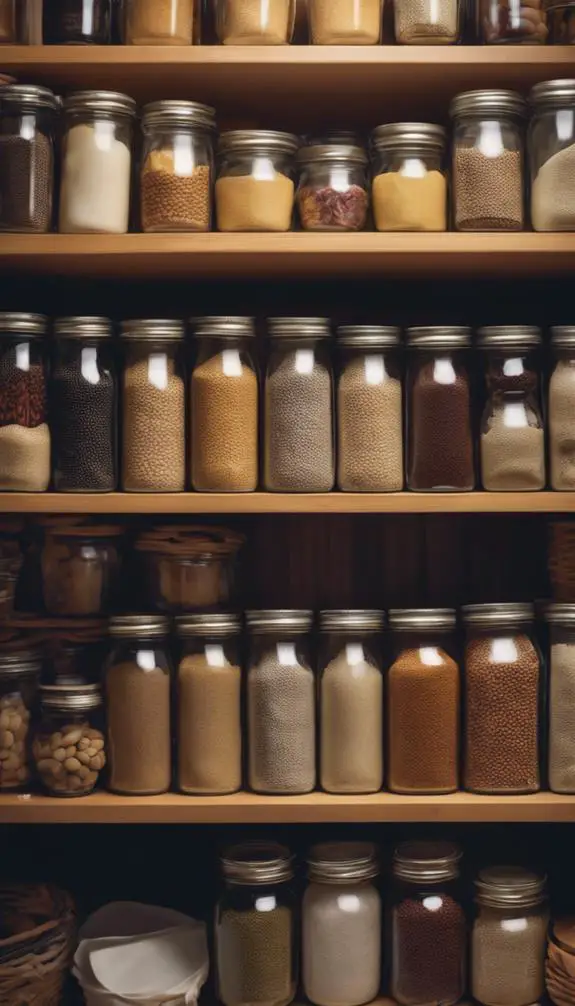So, you wanna be a prepper, huh? Let’s get real: it’s not just about hoarding beans and water. It’s about gearing up for the unpredictable, like a storm that hits when you least expect it. Have you assessed your risks yet? Natural disasters, economic meltdowns—they’re not just headlines; they’re potential reality checks. And trust me, you don’t want to be caught off guard. Ready to dive deeper into the bare-bones of prepping? Let’s get cooking.
Summary
- Conduct a risk assessment to identify local hazards and prioritize preparedness goals based on potential threats.
- Gather essential supplies, including food, water, and survival gear, and maintain an inventory for effective resource management.
- Create an emergency plan with family evacuation routes and communication strategies to ensure everyone is informed and prepared.
- Engage in skill development and community networking to share knowledge and foster trust among like-minded individuals.
- Stay informed about current events and adapt your preparedness plans regularly to accommodate changing circumstances and new information.
Understanding the Basics of Prepping
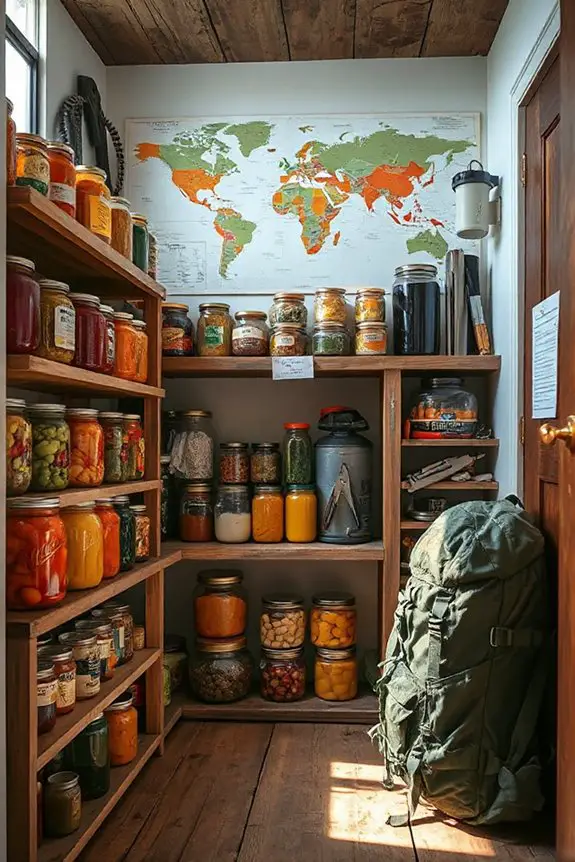
When it comes to prepping, you might think it’s all about stockpiling beans and building a bunker, but hold up—there’s way more to it.
First, you gotta nail the basic principles. It’s not just about hoarding supplies; it’s a prepping mindset—thinking ahead, being resourceful, and staying calm under pressure. Ever faced a blackout? That’s when your prepping shines!
So, start small. Grab essentials, learn skills, and know your local resources. Embrace the grind. Don’t get overwhelmed. It’s about making smart choices today for a safer tomorrow. Conducting a risk assessment is essential to identify potential hazards in your area.
Trust me, you’ll feel like a badass when you’re ready for anything life throws your way!
Assessing Your Needs and Risks
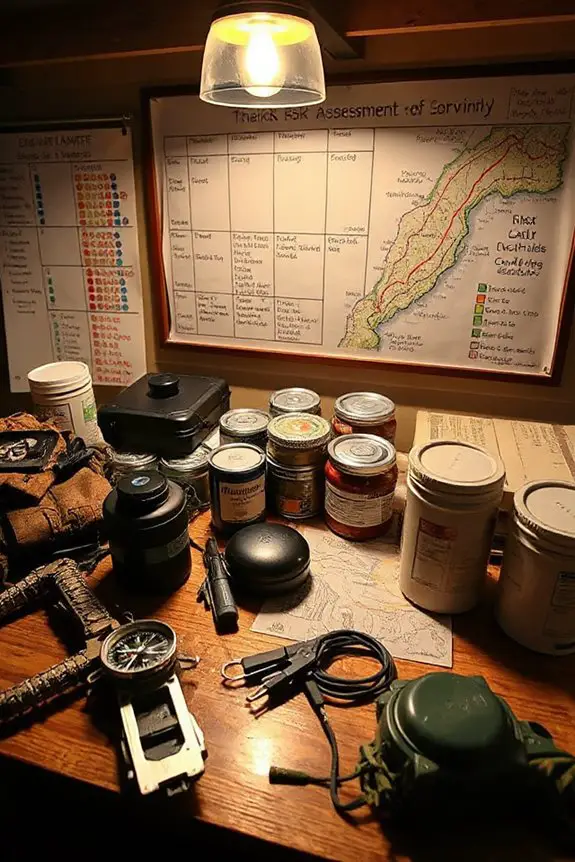
Alright, let’s get real: it’s time to figure out what could go south in your life.
Are you ready to face potential threats head-on? Grab your pencil and paper, ’cause you’ll want to jot down what resources you’ve got and what goals you need to crush to stay ahead of the game. Understanding emergency risks will help you prioritize your prepping efforts effectively.
Identify Potential Threats
Identifying potential threats isn’t just a chore; it’s a wake-up call.
Think about it—natural disasters can strike without warning, leaving you scrambling. Tornadoes, floods, earthquakes—they don’t care about your plans.
And what about an economic collapse? Suddenly, that cushy paycheck’s gone, and you’re left wondering how to feed your family.
It’s not just doom and gloom; it’s reality. So, ask yourself: what’re the threats in my area? What’s my backup plan?
Ignoring these questions is like playing with fire. Get real. Prepare, or risk being caught with your pants down. Trust me, you don’t want that.
Additionally, consider the importance of financial preparedness during uncertain times to secure your family’s future.
Evaluate Resources Available
You can’t just sit back and hope for the best; it’s time to roll up your sleeves and figure out what you’ve got in your corner.
Start with a resource inventory—grab a pen and jot down everything: food, water, tools, and skills. Yeah, that’s right, skills count!
Then, think about resource allocation. How can I use what I’ve got most effectively? What’s the best bang for my buck?
Don’t forget to check expiration dates. Spoiled food isn’t going to save you.
And if you’re sitting on a stash of junk, it’s time to let go. Be smart, be real. Additionally, consider stocking non-perishable food essentials to ensure you have a reliable food supply during emergencies.
Prioritize Preparedness Goals
When it comes to prepping, it’s not just about stashing away cans of beans and bottled water; it’s about knowing what you really need to survive.
I mean, do you know your risks? Goal setting is vital. Start with a priority assessment. What’s your biggest threat? Natural disasters? Economic collapse?
List your must-haves—food, water, gear—then rank ‘em. Don’t waste time on fancy gadgets if you can’t even cook rice! Focus on what’ll keep you alive.
Trust me, you want to be ready, not just busy. Prep smart, not hard. And remember, it’s not about panic; it’s about preparedness. Conduct a thorough threat assessment
to identify potential catastrophic events that may impact your survival.Creating a Comprehensive Emergency Plan
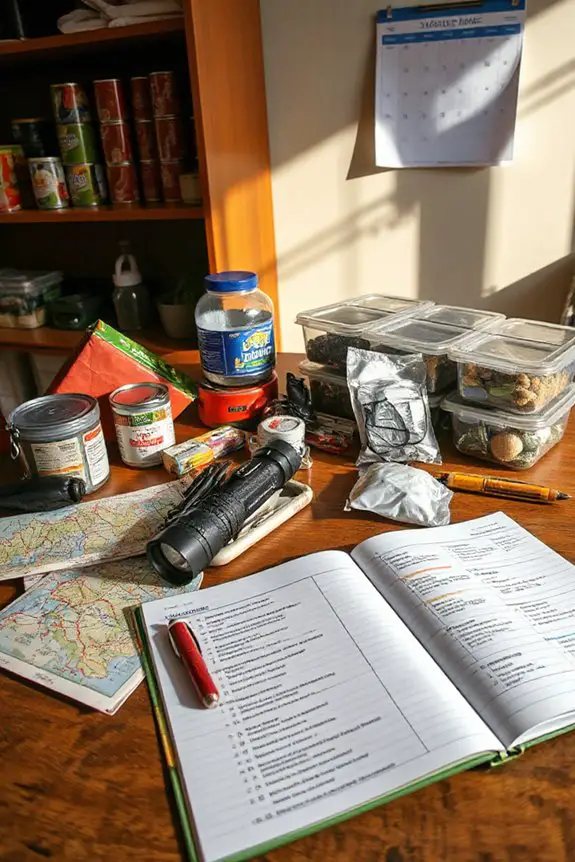
Creating a thorough emergency plan isn’t just a good idea; it’s a damn necessity. You think chaos won’t knock on your door? Think again.
First, nail down those family evacuation plans. Everyone needs to know where to go, and fast.
Next, set up emergency communication methods—text, calls, smoke signals, whatever works. Make it clear; don’t leave room for confusion.
Practice drills like you’re in military training—because in an emergency, hesitation kills. Additionally, consider incorporating a power outage kit to ensure you have essential supplies ready when the lights go out.
And hey, add a backup plan for your backup plan. It’s not paranoia; it’s preparation.
Now, grab your family and get to work—time waits for no one!
Building a Sustainable Food Supply
Building a sustainable food supply isn’t just a nice-to-have; it’s a game-changer. You want to eat? Start with crop rotation. Plant different stuff each season; it keeps pests confused and your soil happy.
Then, there’s food preservation. Ever tried canning? It’s like magic—turning fresh veggies into long-lasting goodness. Seriously, if you don’t know how to pickle, you’re missing out!
Consider also stocking up on high-nutrient options to ensure your food supply is both diverse and nutritious.
Think about it: a pantry full of homemade pickles beats the store-bought junk any day. So, roll up your sleeves, get dirty, and embrace the grind. Your future self will thank you, trust me!
Are you ready to dig in?
Stocking Essential Supplies and Gear
Alright, let’s get real about stocking essential supplies and gear.
You can’t just wing it when the world goes sideways—trust me, I’ve learned that the hard way.
So, what’s on your survival checklist? Essential food items? Survival gear?
Let’s break it down, because when it hits the fan, you’ll want to be ready, not scrambling like a chicken with its head cut off.
Essential Food Items
When it comes to stocking essential food items, there’s no time for half-measures—it’s all or nothing. I’m talking about canned goods—those shiny little life-savers lining your pantry. They won’t spoil, and they pack a punch. Think beans, veggies, and soups.
Then there are freeze-dried meals—lightweight, long-lasting, and ready to revive your taste buds when the world’s gone haywire. Seriously, who wants to slurp on soggy survival rations?
Survival Gear Checklist
You might think survival gear is just a bunch of fancy gadgets you see in those doomsday prepper shows, but let me tell you, it’s your ticket to staying alive when chaos hits.
First, grab essential survival tools: a sturdy knife, fire starter, and a water filter.
Don’t skimp on first aid supplies either—bandages aren’t just for paper cuts!
Oh, and gear maintenance? It’s non-negotiable. Keep everything in top shape—rusty tools won’t save you.
Ever tried starting a fire with a broken lighter? Yeah, not fun.
Developing Practical Skills for Survival
A solid skill set can make the difference between thriving and just surviving. You can’t just wing it—learn first aid, or you might be your own worst enemy.
Self-defense? Yeah, it’s not just for movie stars. Get comfortable with wilderness survival, because Google won’t be there in a crisis.
Master gardening techniques for fresh food, and practice fire making—cold beans aren’t the goal. Foraging skills? Essential.
Navigation skills? Don’t get lost! Water purification is a must, and trapping animals can save your bacon.
Finally, build mental resilience. Seriously, it’s your secret weapon.
Ready to get your hands dirty? Let’s go!
Establishing a Community of Like-Minded Preppers
Establishing a community of like-minded preppers is like cooking up a hearty stew—each ingredient matters, and the right mix can turn survival into thriving.
You need to immerse yourself in community networking; that’s where the magic happens. Find folks who share your passion, and don’t be shy about skill sharing. Got a knack for foraging? Teach it! Can you make fire without matches? Show off that talent!
It’s about building trust and camaraderie. Remember, we’re all in this together, and a strong community can tackle anything.
Staying Informed and Adapting to Change
When the world spins out of control, staying informed isn’t just smart—it’s your lifeline. I mean, how else are you gonna know what’s brewing?
I tap into solid information sources—news apps, survival blogs, and even podcasts. They keep my prepper brain sharp.
But here’s the kicker: it’s not just about gobbling up info; it’s about adapting strategies. If the world shifts, I shift with it.
That means ditching old plans that no longer work and cooking up fresh ones. Be flexible. Stay alert.
Because if you’re not ready to pivot, you might as well be marinated in ignorance.
FAQs
What Is the Best Way to Start Prepping With a Limited Budget?
Starting with a tight budget? I’ve been there.
First, grab budget-friendly supplies—think canned goods, seeds, and a solid first-aid kit.
Next, don’t just hoard; learn essential skills! Can you cook from scratch? Grow a garden? Yes? Then you’re ahead of the game.
Use free resources online, and don’t forget to barter with friends. Seriously, who doesn’t love a trade-off?
Prepping doesn’t have to break the bank; it just takes creativity and grit.
How Can I Convince My Family to Join My Prepping Efforts?
Want your family on board with prepping? Start some family discussions that aren’t boring—make ‘em lively!
Share your vision and how it ties into shared goals. I once laid out a scenario—what if a storm hit us? It got everyone thinking.
Don’t sugarcoat it, either. It’s about survival, not just fun. Toss in some snacks to keep it light, and remember: it’s teamwork.
Make ‘em see the value, and they’ll be all in!
What Should I Do if I Run Out of Supplies During an Emergency?
Running out of supplies? Panic isn’t an option.
First, tap into resource management—think outside the box. Scavenge your neighborhood or trade with neighbors.
Got any hidden stashes? Dig ‘em up. Alternative sourcing is key; hit local farms, or barter skills for food.
Seriously, don’t underestimate the power of a well-placed “I’ll fix your fence if you give me some tomatoes.”
Keep your head cool, and hustle—survival’s a full-time gig!
Are There Specific Prepping Mistakes I Should Avoid as a Beginner?
Oh, absolutely! As a beginner, I’ve made my fair share of mistakes.
One common pitfall? Overbuying junk you’ll never use. Seriously, it’s like hoarding kitchen gadgets you forget exist.
Another? Ignoring skills. You can stockpile all the beans, but if you can’t cook ‘em, what’s the point?
Also, don’t skimp on training—practice makes perfect. Trust me, skipping this step is a rookie error you’ll regret when the crunch hits!
How Do I Stay Motivated in My Prepping Journey Over Time?
Staying motivated in my prepping journey? It ain’t easy, but I’ve got some tricks.
First, I set clear prepping goals—specific, bite-sized ones. It keeps me laser-focused. I celebrate small wins, like stocking up on water or mastering a new skill.
Boredom’s a killer, so I mix it up—join a community or try out new gear.
Seriously, if I can do it, you can too. What’s more important than being ready? Nothing. So, get after it!
Conclusion
So there you have it: prepping isn’t just a hobby, it’s a lifestyle! You’ve got the skills, the supplies, and the savvy to face whatever life throws your way. Don’t wait for disaster to knock on your door—take charge now! Build your plan, stock your pantry, and connect with your crew. Remember, it’s not about living in fear; it’s about being ready. So get out there, roll up your sleeves, and prep like your life depends on it—because it just might!

